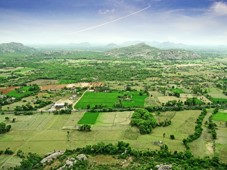
Climate-smart conservation is a dynamic process to explicitly address climate impacts in conservation responses. Flexibility is key, with both management actions and conservation goals evolving with time. It is important to consider how species may move across landscapes and regions and plan for both current and future needs.

Climate change is already influencing species distributions (Zuckerberg et al. 2009, Auer and King 2014, Environmental Protection Agency 2014, Virkkala and Lehikoinen 2014, Gillings et al. 2015) and species interactions (McKinnon et al. 2012, Møller et al. 2010, Adamık and Kral 2008). Conservation action can therefore no longer have the traditional view of preserving ecosystems in their current state, or restoring habitat to a historical state, because environmental conditions are increasingly dynamic, making it essential for management to be dynamic too (Stein et al. 2014).
Large avian community, behaviour and general ecosystem changes are predicted by the end of the century (Huntley et al. 2008, Barbet-Massin et al. 2009, Hole et al. 2009, Araujo et al. 2011, Bagchi et al. 2013, Langham et al. 2015), and unless emissions are vastly reduced, these changes are likely to extend into future centuries. Future needs therefore need to be incorporated into management actions, as well as placing management action into the broader landscape context. To enable effective conservation into the future and across whole landscapes, a large number of private stakeholders will need to be on board.
Whilst many species may be able to adapt to changing environmental conditions (Devictor et al. 2012), there are limits to these abilities, and this will be largely affected by the speed and intensity of climate change. A species may for example be able to adapt to a gradual change, but not a rapid change. Additional conservation measures will be vital for enabling many populations to adapt. An example of this includes the management of drought sensitive drained peatlands wherein the blocking of drains may benefit Eurasian Golden Plovers Pluvialis apricaria by helping to maintain cranefly numbers (Carrol et al. 2011).
Management actions must where possible account for uncertainty; uncertainty in how species will respond, how much climate will change or how humans might respond to their changing environment. Approaches that result in an acceptable outcome across multiple possible scenarios will be preferable to investing time and money into an action that may only work when depending on certain assumptions. Predictions on how bird ranges are expected to shift under climate change tend to account for uncertainty by predicting them under several emission scenarios (Bagchi et al. 2013, Langham et al. 2015) or through accounting for differing species responses (Schuetz et al. 2015). The relative importance of different sites can therefore be identified with some confidence, regardless of differing emission trajectories or little known species dispersal abilities.
Management adaptations can be either reactive or anticipatory, and the instances in which one becomes more likely than the other will change. Overall, forward thinking actions are therefore required, and flexibility is key; the impacts of any actions implemented should be monitored to enable effective evaluation, feedback and subsequent adjustment to practise (Stein et al. 2014).
This case study is taken from ‘The Messengers: What birds tell us about threats from climate change and solutions for nature and people’. To download the report in full click here.
Related Species
References
Compiled: 2015 Copyright: 2015
Recommended Citation:
BirdLife International (2015)
Conservation planning is incorporating climate change.
Downloaded from https://datazone.birdlife.org/sowb/casestudy/conservation-planning-is-incorporating-climate-change on 22/12/2024